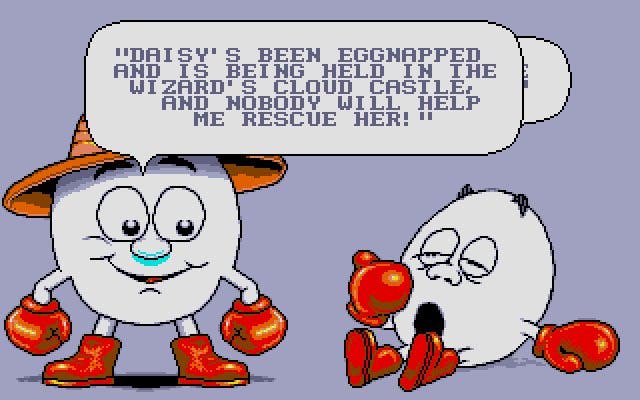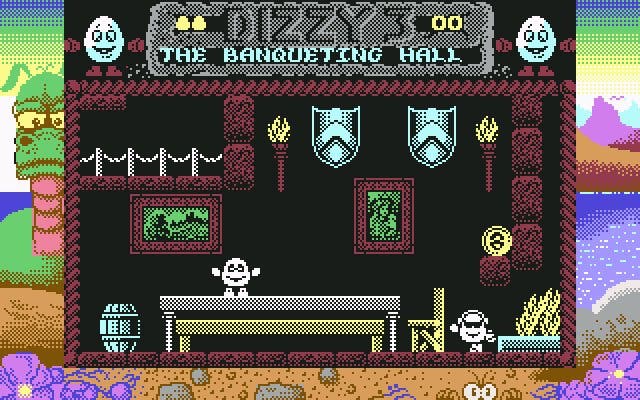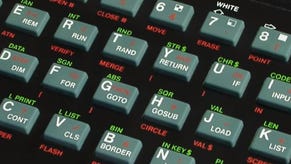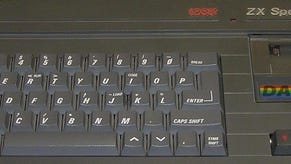Fantasy World Dizzy
The story behind the classic.
While the basic game structure of the previous two titles remained (including the coin collecting sub-plot of Treasure Island), Fantasy World placed Dizzy in far greater peril and in the kind of environment the Oliver twins had always envisioned for their character; filled with fairy tale imagery, trolls, dragons, magic realms and cloud castles. And even the story reinvented the classic, heroic endeavour of rescuing a damsel in distress from the tall tower of an evil entity.
Beginning under guard in the evil wizard's dungeons, Dizzy's adventures begin immediately. On one side, the impassable malice of a green and monstrous troll, and on the other a roaring fire blocks his escape. But this seemingly harsh introduction sets up the requirements of the game superbly, and before long Dizzy is skipping through the castle, tree house, dungeons and even the sky on his quest to free his girlfriend Daisy.
To increase the intrigue of the simple, yet challenging puzzles, the addition of the Yolkfolk proves to have been a resounding success. As Dizzy's progress moves gradually forward, new areas are unlocked and each of The Egg's kin are gradually reacquainted with their heroic Prince. Each has a story to tell, a clue to uncover and an item valuable to Dizzy's quest. While not playing a particularly intrinsic part of the game, each member of the Yolkfolk serves an important function, and not simply in terms of kitting out Dizzy.
One of the reasons gamer's finally felt so attached to the hero of the adventure platforming trilogy was the small, yet vital introduction to the life of the main character when he wasn't stranded on an island or ridding the land of an evil menace. The promise of an entire race of Yolkfolk expanded the world of Dizzy in the player's imagination exponentially, and the depth of his tasks could be realistically enhanced without resorting to raw exposition or random, unpredictable puzzles.

"We wanted Dizzy to have friends" recalls Philip. "He'd had a pretty horrible and lonely existence up until Fantasy World Dizzy. We didn't want every character he met to be an enemy, and we wanted extreme stereotypes for comic effect. Daisy and Dora were based largely on Velma and Daphne from Scooby Doo. Dylan the Hippy was a cross between Neil from The Young Ones and Dylan the Rabbit in Magic Roundabout, whilst Grand Dizzy was based on the grandad in Only Fools and Horses."
As a Dizzy obsessed player, it's easy to overlook the subtle nuances such background details brings to a finished game, and the Yolkfolk served their purpose of expanding Dizzy's increasingly entertaining folklore brilliantly.
One other issue raised by the amazingly short development cycle of Fantasy World Dizzy is the technical requirements. The look of Dizzy hadn't changed much over the three games, though he'd always lived in a colourful, chunky and increasingly vast world.
"From a technical point of view it was extremely easy." Philip explains. "We'd optimised both the engine and the tools over our previous platform games and had a very slick pipeline. Obviously the style and main graphics were actually the same as Treasure Island Dizzy, so we were able to build it with ease and in only one month.

"The big issue we always faced was squeezing everything into the memory; just 30k of usable RAM. Often we spent the last few days optimising assembly level routines to save literally a few bytes of memory!"
1989 was a time of technical transition. Although the forthcoming 16-bit versions had considerably more memory and processing power to play with, the Oliver's were still working from their faithful old warhorse on the 8-bit platform, so including even a short snippet of digitised speech was always enough to make gamer's sit up and pay attention.
"In most of our games it was either Andrew or me speaking, and actually we sound the same, so nobody would know! We were very proud of our digital speech system, but sadly it took a lot of memory. One thing that we wished we had of done was properly exploit the memory of the Spectrum 128K." he recalls, looking back at the few areas where Fantasy World could possibly have been augmented. "We made sure all our games fitted on the base 48k Spectrum. If people had more memory then the tape would continue and there would be some additional graphics loaded, but nothing of any real significance.

"It would've been great if we'd recorded dialogue for all the characters and actually had them speak their lines. This would have added tremendously to the game and made it stand head and shoulders above other games at the time."
With each new incarnation, Dizzy found himself bounding across more and more different platforms. Fantasy World Dizzy was ported to all three popular 8-bit micros, DOS, the Amiga and the Atari ST. Although the Oliver's tended to concentrate mainly on the Amstrad and Spectrum versions, each port was handled with the care and attention The Egg deserved, and this bride to the next generation of machines cemented a future for the Yolkfolk.
And, although the Dizzy games continued to appear, this was the last time the Oliver Twins handled the entire production on their own. Naturally, the question Philip and Andrew must answer every time they appear in public is related to this promising future of their wonderful character. But what the hell. Let's ask it again, anyway.

"We'd love to create new Dizzy games, at some point." says Philip, not at all perturbed at this rather insolent, and over asked question. "As for the style, it would depend on the platform. 2D works best on handhelds while we'd have to go full out 3D if we were producing boxed console games. I guess the Amiga 2D games could just about work on XBLA. We've talked about this with Codemasters over the years, but nothing's yet been concluded."
Some small glimmer of hope is better than none, and with the massive Dizzy fan based already installed since his fairy tale was first whispered into a child's ear over 20 years ago, coupled with the summery retro-remake climate we've all be enjoying recently, the future certainly appears to be sunny side up for the Prince of the Yolkfolk.











